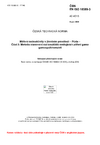Vánoční provoz a PF 2026
Vážení zákazníci,
aby bylo možné dodat objednané zboží před začátkem vánočních svátků, odešleme poslední várku zboží v tomto roce v pátek 19. prosince. Objednávky došlé po 10. hodině 19. prosince odešleme až 5. ledna 2026. Od 19. prosince do 2. ledna taktéž nebude možný osobní odběr objednaných norem.
Děkujeme za váš zájem v tomto roce,
přejeme vám hodně zdraví, pohody a úspěchů v roce 2026.
ČSN EN ISO 18589-3 (404015) Aktuální vydání
Měření radioaktivity v životním prostředí - Půda - Část 3: Metoda stanovení radionuklidů emitujících záření gama gamaspektrometrií
Anotace obsahu normy
This document specifies the identification and the measurement of the activity in soils of a large number of gamma-emitting radionuclides using gamma spectrometry. This non-destructive method, applicable to large-volume samples (up to about 3 l), covers the determination in a single measurement of all the ?-emitters present for which the photon energy is between 5 keV and 3 MeV.
Generic test method and fundamentals using gamma-ray spectrometry are described in ISO 20042.
This document can be applied by test laboratories performing routine radioactivity measurements as a majority of gamma-emitting radionuclides is characterized by gamma-ray emission between 40 keV and 2 MeV.
The method can be implemented using a germanium or other type of detector with a resolution better than 5 keV.
This document addresses methods and practices for determining gamma-emitting radionuclides activity present in soil, including rock from bedrock and ore, construction materials and products, pottery, etc. This includes such soils and material containing naturally occurring radioactive material (NORM) or those from technological processes involving Technologically Enhanced Naturally Occurring Radioactive Materials (TENORM) (e.g. the mining and processing of mineral sands or phosphate fertilizer production and use) as well as of sludge and sediment. This determination of gamma-emitting radionuclides activity is typically performed for the purpose of radiation protection. It is suitable for the surveillance of the environment and the inspection of a site and allows, in case of accidents, a quick evaluation of gamma activity of soil samples. This might concern soils from gardens, farmland, urban or industrial sites that can contain building materials rubble, as well as soil not affected by human activities.
When the radioactivity characterization of the unsieved material above 200 ?m or 250 ?m, made of petrographic nature or of anthropogenic origin such as building materials rubble, is required, this material can be crushed in order to obtain a homogeneous sample for testing as described in ISO 18589-2.
| Označení | ČSN EN ISO 18589-3 (404015) |
|---|---|
| Katalogové číslo | 519409 |
| Cena | 550 Kč550 |
| Datum schválení | 1. 8. 2024 |
| Datum účinnosti | 1. 9. 2024 |
| Jazyk | angličtina (obsahuje pouze anglický originál) |
| Počet stran | 52 stran formátu A4 |
| EAN kód | 8596135194094 |
| Tato norma nahradila | ČSN EN ISO 18589-3 (404015) z května 2018 |
| Dostupnost | skladem (tisk na počkání) |
Další příbuzné normy
ČSN EN ISO 18589-1 (404015)
Měření radioaktivity v životním prostředí - Půda - Část 1: Obecné směrnice a definice
ČSN EN ISO 18589-2 (404015)
Měření radioaktivity v životním prostředí - Půda - Část 2: Návod pro výběr strategie vzorkování, odběr vzorků a jejich prvotní zpracování
ČSN EN ISO 18589-4 (404015)
Měření radioaktivity v životním prostředí - Půda - Část 4: Plutonium 238 a plutonium 239 + 240 - Zkušební metoda pomocí alfa spektrometrie
ČSN EN ISO 18589-5 (404015)
Měření radioaktivity v životním prostředí - Půda - Část 5: Stroncium 90 - Metoda proporcionálního počítání nebo kapalinová scintilační metoda
ČSN EN ISO 18589-6 (404015)
Měření radioaktivity v životním prostředí - Půda - Část 6: Celková objemová aktivita alfa a celková objemová aktivita beta - Zkušební metoda pomocí proporcionálního průtokového detektoru
ČSN EN ISO 18589-7 (404015)
Měření radioaktivity v životním prostředí - Půda - Část 7: In situ měření radionuklidů emitujících záření gama


